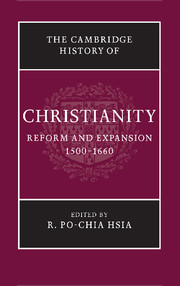Book contents
- Frontmatter
- Part I Luther and the Holy Roman Empire
- Part II The Second Reformation
- 5 Communal Reformation: Zwingli, Luther, and the South of the Holy Roman Empire
- 6 The Calvinist Reformation in Geneva
- 7 The Theology and Liturgy of Reformed Christianity
- 8 The Second Wave of Protestant Expansion
- Part III Catholic Renewal
- Part IV Resolving Confessional Conflicts
- Part V Religion, Society, and Culture
- Part VI Christianity and Other Faiths
- Bibliography
- Index
- References
5 - Communal Reformation: Zwingli, Luther, and the South of the Holy Roman Empire
from Part II - The Second Reformation
Published online by Cambridge University Press: 28 March 2008
- Frontmatter
- Part I Luther and the Holy Roman Empire
- Part II The Second Reformation
- 5 Communal Reformation: Zwingli, Luther, and the South of the Holy Roman Empire
- 6 The Calvinist Reformation in Geneva
- 7 The Theology and Liturgy of Reformed Christianity
- 8 The Second Wave of Protestant Expansion
- Part III Catholic Renewal
- Part IV Resolving Confessional Conflicts
- Part V Religion, Society, and Culture
- Part VI Christianity and Other Faiths
- Bibliography
- Index
- References
Summary
In the German historical tradition, the Reformation has for centuries been interpreted as a ‘national’ event. Leopold von Ranke, the co-founder of critical historical science in the first part of the nineteenth century and one of its most profound proponents, greatly influenced conventional wisdom on this subject up until the 1960s. According to this, Martin Luther’s theology was the purest form of Christianity and was promoted throughout the world by the efforts of the German nation. ‘Nation’ and ‘the people’ (das Volk) were frequently used synonymously despite the fact that neither the question as to how the people were incorporated into the reformers’ theology nor how the people were thought to have supported it have been adequately examined. This, however, has changed over the last thirty years. The Reformation was one of the most prominent subjects of social history in Germany, as well as in England and the United States. Under close scrutiny it became obvious that both urban inhabitants and rural peasants were the most ardent supporters of the Reformation and that neither the nobility nor the majority of the clergy were in favour of it. Contemporary sources attribute the support of the Reformation to the ‘common man’ (der gemeine Mann), a category that included those sections of society involved in manual labour and not in any way wielding ‘power’, in particular peasants and burghers, or, as European social theory has labelled them, the estate of the ‘laboratores’. The prime social and political context for both the rural and the urban common man was the community.
- Type
- Chapter
- Information
- The Cambridge History of Christianity , pp. 73 - 89Publisher: Cambridge University PressPrint publication year: 2007



